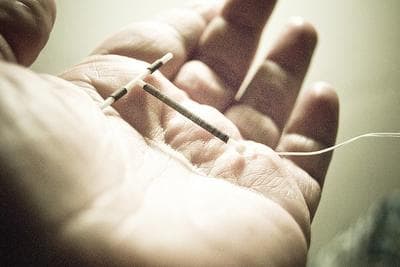Advertisement
10 Reasons To Get An IUD, And 5 Downsides

Our recent post on why IUDs are on the rise has been going gangbusters, so for those interested in more bite-sized chunks of information, here's a distillation:
After being out of style for decades, IUD use has been rising rapidly among American women in recent years, spurred by strong endorsements from birth-control experts. IUDs are by no means for every woman, but top women's health authorities are saying they're a good option for most women — unlike the old days when, because of the risk of infection, they were recommended only for women who'd already had children.
This post is not numerically balanced because birth control experts are not balanced: They argue that the IUD is under-used. But let's start with some downsides:
1. IUDs don't protect against sexually transmitted infections. A reader who's happy with her own IUD points out: "An IUD is an effective form of birth control NOT a way to practice safe sex."
2. Though current IUDs have caused nothing like the 1970s fiasco of the dangerous Dalkon Shield, complications still do arise. As Judy Norsigian of Our Bodies, Ourselves noted: "Like every method, it has its downsides. There’s a remote risk of embedding and perforation, but it’s small. And some women have a lot of pain, others don’t. Some women expel the IUD, others don’t."
Two IUDs are in use these days: The copper Paragard and the hormone-emitting Mirena. Each has some minuses:
3. The copper Paragard can lead to heavier periods.
4. The Mirena makes periods diminish or disappear, which some women don't like.
5. Also, though their levels are very low, the hormones that the Mirena emits can affect some women. A friend of mine just had her Mirena pulled because of nasty, depressive symptoms. It's a well-trodden path for women to replace the hormonal Mirena with the copper Paragard.
This is not an exhaustive list. But as our IUD-using reader said, "One great thing about needing a procedure to get this type of birth control is that it will allow you to have conversations with your ob-gyn and have an honest discussion about what kind of birth control suits your lifestyle." That conversation should also include a run-down of the risks. A helpful IUD fact sheet is here.
Now for the upsides:
1. "Just one act": It takes a doctor's visit to have an IUD implanted, but then your birth control is likely set for years.
2. Effective: Once that "one act" is done, the device is close to 100% effective.
3. Cost: The IUD is also considered one of the most cost-effective forms of birth control; though it costs several hundreds dollars up front, that cost is spread out over years, and...
4. New coverage rules: Under new federal rules that take effect starting next summer, insurance companies must cover FDA-approved contraception, which includes the IUD, with no co-pays or additional fees.
5. Periods diminish or disappear with the Mirena — considered a plus by many women.
6. The Paragard offers effective long-term birth control without hormones.
7. Though IUDs work long-term, their birth control effect is reversible: once they're out, it ends.
8. They're private: As this fact sheet points out, an IUD cannot be seen or felt.
9. Recent research suggests IUDs are safe enough to be implanted at what I'd call a "never again" moment, right after a birth or an abortion.
10. Other countries have much higher rates than America does, with good success, while we have a shocking accidental pregnancy rate of nearly 50%.
Readers, please write in suggested additions to this list in the comments below.
